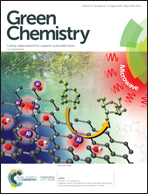Continuous flow upgrading of glycerol toward oxiranes and active pharmaceutical ingredients thereof†
Abstract
A robust continuous flow procedure for the transformation of bio-based glycerol into high value-added oxiranes (epichlorohydrin and glycidol) is presented. The flow procedure features a central hydrochlorination/dechlorination sequence and provides economically and environmentally favorable conditions involving an organocatalyst and aqueous solutions of hydrochloric acid and sodium hydroxide. Pimelic acid (10 mol%) shows an exceptional catalytic activity (>99% conversion of glycerol, a high selectivity toward 1,3-dichloro-2-propanol and 81% cumulated yield toward intermediate chlorohydrins) for the hydrochlorination of glycerol (140 °C) with 36 wt% aqueous HCl. These conditions are validated on a sample of crude bio-based glycerol. The dechlorination step is effective (quantitative conversion based on glycerol) with concentrated aqueous sodium hydroxide (20 °C) and can be directly concatenated to the hydrochlorination step, hence providing a ca. 2 : 3 separable mixture of glycidol and epichlorohydrin (74% cumulated yield). An in-line membrane separation unit is included downstream, providing usable streams of epichlorohydrin (in MTBE, with an optional concentrator) and glycidol (in water). The scalability of the dechlorination step is then assessed in a commercial pilot-scale continuous flow reactor. Next, bio-based epichlorohydrin is further utilized for the continuous flow preparation of β-amino alcohol active pharmaceutical ingredients including propranolol (hypertension, WHO essential), naftopidil (prostatic hyperplasia) and alprenolol (angina pectoris) within a concatenable two-step procedure using a FDA class 3 solvent (DMSO). This work provides the first example of direct upgrading of bio-based glycerol into high value-added pharmaceuticals under continuous flow conditions.



 Please wait while we load your content...
Please wait while we load your content...